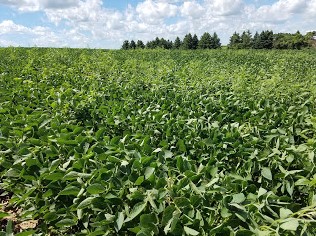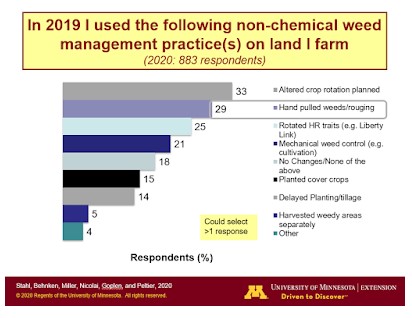By Lisa Behnken and Jared Goplen
Some Reminiscing
My dad was a dairy farmer his entire life. When he was 41 he had a heart attack and had to take a year off. He rented the farm to a neighbor, who planted 80 acres of soybeans on part of the farm. Soybean herbicides were limited at that time so weed control was a bit challenging. My dad offered up my brother and me to walk those beans and hoe out the “buttonweed” (velvetleaf) and volunteer corn. At the age of 10 and 11, my brother and I walked beans all summer long. Countless hours of hoeing and pulling weeds—sometimes four rows at a time, sometimes less. Some days we carried a radio, which meant mandatory breaks whenever “Layla” or “Let it Rain” (both by Eric Clapton) came on the radio. At the end of the summer, our efforts and hard work paid off. When the beans were combined our neighbor came to pay us. He told us that we’d done such a good job that he sold the beans for “seed” beans and made a nice profit. He gave each of us a $50 bill. I remember our eyes getting very wide, “We are rich!”
Check for Weed Escapes
This is the time of year that we evaluate our soybean fields for a number of pests, including weed escapes. Oftentimes by early August, escaped waterhemp, giant ragweed and other weeds have creeped above the canopy. Frustration can set in, and the temptation to “spray something” creeps into our minds. Just say, “No.” As Jeff Gunsolus, University of Minnesota Professor Emeritus used to say, “Nothing good happens in July.” This extends into August when it comes to using herbicides to target weed escapes.

Waterhemp escapes in soybeans in late July.
Here is your August weed control plan: walking, hoeing, mapping, and mowing. That’s it.
The only spraying that should be considered is in the road ditches and along fencelines, waterways, and field edges that can’t be mowed. Be sure to spray with care. Follow herbicide labels and note sensitive crops and plants that may be nearby.
Why bother?
The goal is to reduce weed seed production. If escaped weeds are allowed to produce seed they have the potential to stick around for decades. Giant ragweed does not produce viable seed until near the end of August, so hoeing out patches now is very effective at preventing seed production. Preventing seed production will dramatically decrease the weed seedbank. In just two years, over 95% of giant ragweed seeds will be degraded from the weed seedbank if seed production is prevented.
Waterhemp can be a bit more challenging because it produces viable seed soon after it starts to flower (by early August in some cases). However, reducing weed seed production is still a good goal to strive for. Fortunately, for waterhemp, 90% of the viable seeds will be degraded within 4 years.
Investigating weed escapes is also cheap insurance for preventing Palmer amaranth from getting established on your farm. If you find a pigweed that doesn’t look quite right, check out our resources on how to identify Palmer amaranth and Amaranth family identification.
The Plan
August weed control plan – Walk, Hoe, Map and Mow. Based on the results of the IPM assessment we conduct during the Private Pesticide Applicator Recertification meetings, almost 30% of farmers have been walking their fields to control weeds in recent years (Figure 1). Good work, keep it up!

Figure 1. Survey responses from private pesticide applicator
training across MN in 2020.
This is your best weed control plan from now until harvest:
- Walk your fields and hoe or pull out what you can.
- Map the areas that need more attention next year. Pay attention to the areas that usually get missed by the sprayer or get flooded regularly. What else can you do in these areas?
- Mow as much of the weedy areas as you can to prevent seed set and to keep the combine from spreading more seed throughout your fields, even if it costs you a few bushels.
- Think about how your weed management plan can address these weed escapes for next year. Did weeds escape because they are resistant to the herbicides used?
- Keep a lookout for Palmer amaranth.
Finally, due to the increase in weed species resistant to multiple classes of herbicides, it is becoming more and more evident that herbicides alone (either existing or new chemistry) cannot provide us with durable and sustainable weed management. Diversification of tactics, understanding weed biology and recognizing the agronomic impacts of our weed management decisions is necessary to address the changing weed landscape.
Some things never change
Am I still walking soybean fields? Yes, and Jared does, too. It still isn’t my favorite activity, but it is good exercise, it is quiet time to think, and each weed I pull now means thousands fewer seeds going back into the seedbank for next year. The only problem is I don’t get paid as much as I used to…

Waterhemp escape towering over the soybean
canopy in western MN.
Source : umn.edu